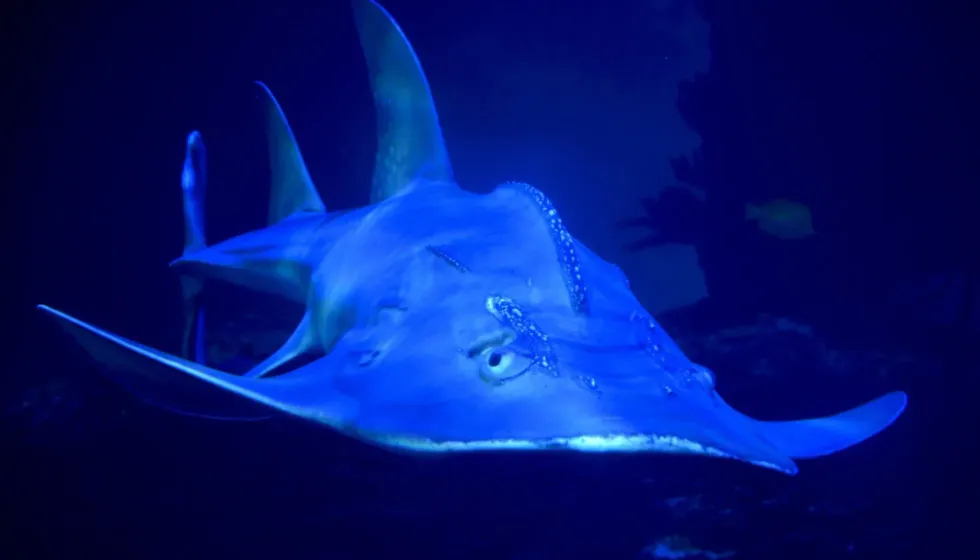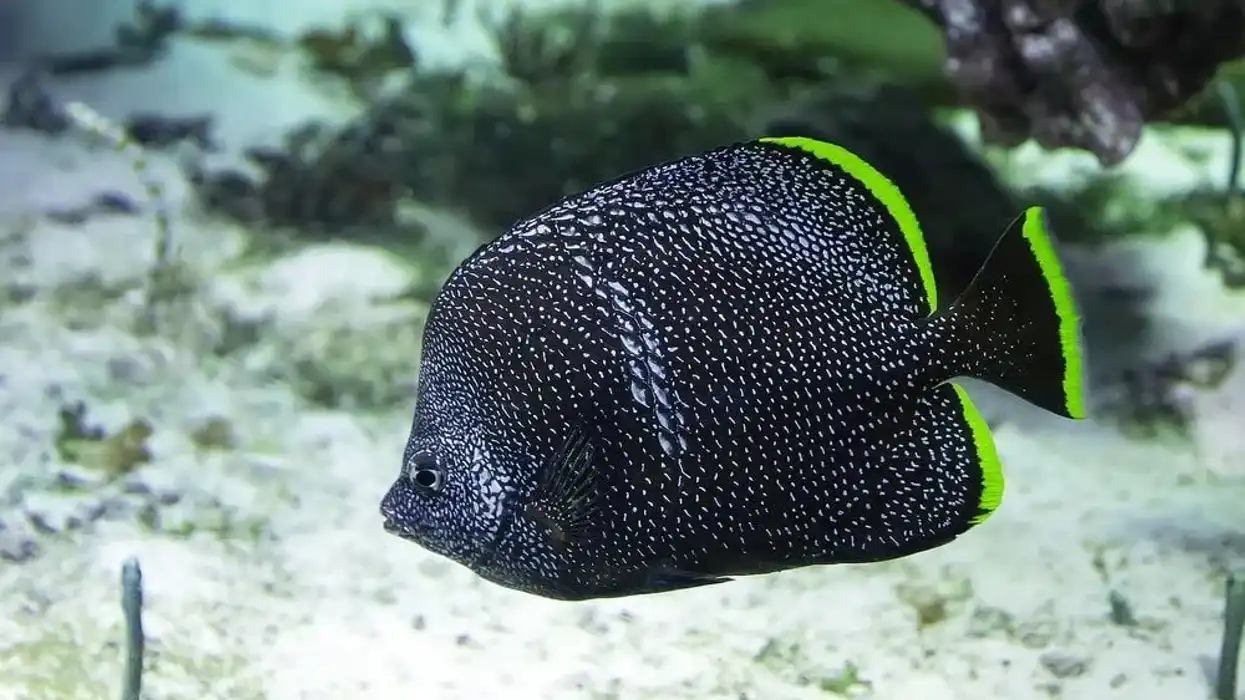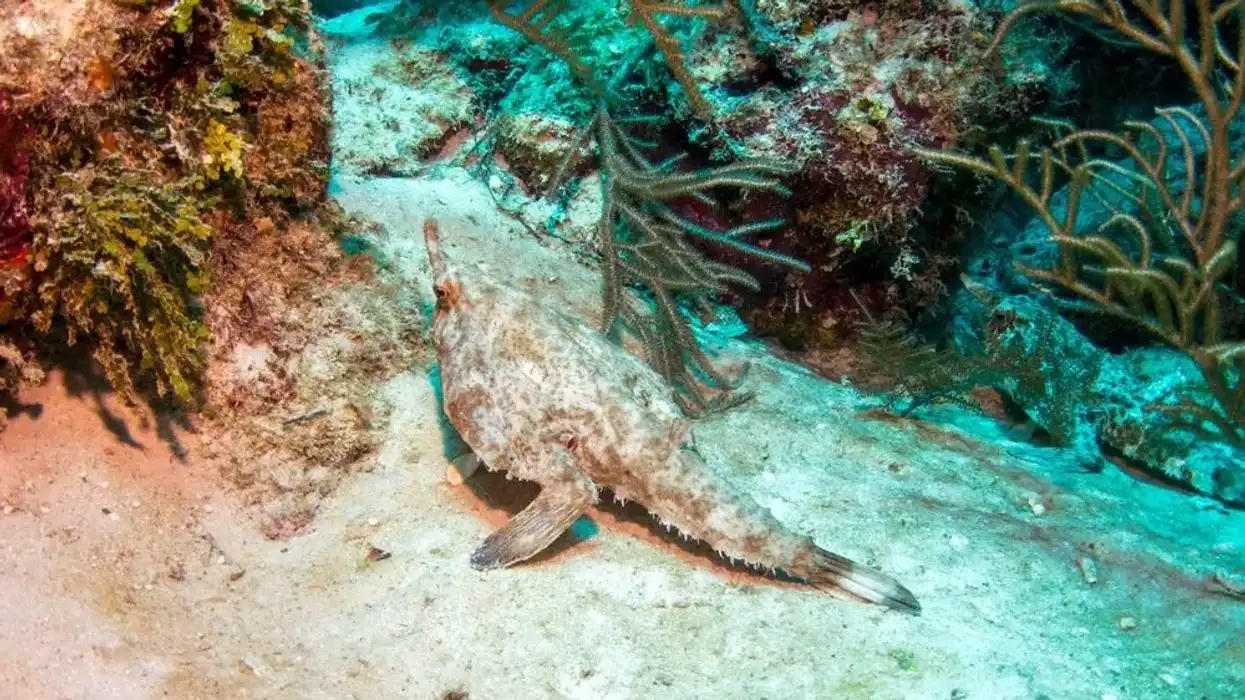A bowmouth guitarfish is generally found in sandy or muddy habitat and in between rocks or shipwrecks and coral reefs. The species is highly vulnerable to commercial fisheries and artisanal requirements. Its skin looks vibrant with white spots.
The eyes are large, and the lower and upper jaws are composed of ridged teeth. The pectoral fins are larger than pelvic fins, which streamline the body. The pectoral fins and dorsal fins are large and are similar to the fins of sharks and rays.
One interesting fact about guitarfish is that they can camouflage their body color with the surrounding environment while swimming. The upper part of the body is covered with white spots while the underside is white, which helps them to hide from big predators like sharks.
Bowmouth guitarfish from the family of rays is a Critically Endangered species found in the Indo-west Pacific region in the Indian Ocean.
Investigator Dave Albert from east Africa, on examining guitarfish, found their range from South Africa to the Red Sea and Southeast Asia to Western Australia. In the north, they can be found up to Korea and Papua New Guinea to the east.
For more relatable content, check out these longhorn cowfish facts and milkfish facts for kids.
Bowmouth Guitarfish Interesting Facts
What type of animal are bowmouth guitarfish?
Bowmouth guitarfish is a type of fish and belongs to the species of Ray.
What class of animal do bowmouth guitarfish belong to?
Bowmouth guitarfish has the scientific name Rhina ancylostoma and comes from the class of Chondrichthyes.
How many bowmouth guitarfish are there in the world?
The exact number of bowmouth guitarfish, that look like a shark is unknown. But Rhina ancylostoma is vulnerable because of commercial fisheries.
Where do bowmouth guitarfish live?
Bowmouth guitarfish is found in the coastal tropical waters of the Indo-west Pacific region. Investigator Dave Albert from east Africa, on examining the bowmouth, found them in the Indian Ocean that ranges from South Africa to the Red Sea.
The Pacific range extends to Korea and Japan in the north, to Papua New Guinea in the east, and New South Wales in the south.
What is a bowmouth guitarfish's habitat?
The bowmouth guitarfish or mud skate from the family of the ray are species found in mid-sea and near the seafloor too. They are found in the Indo-west Pacific region. Rhina ancylostoma can be found at depths ranging from 10-300 ft (3-91.4 m). They prefer sandy or muddy habitat, in between rocks or shipwrecks and coral reefs.
Who do bowmouth guitarfish live with?
Generally, bowmouth guitarfish from the ray family live independently in between rocks or shipwrecks and coral reefs but form pairs during reproduction. The babies scatter out after birth and live independently without any care from parents.
How long do bowmouth guitarfish live?
The lifespan of wild bowmouth guitarfish or mud skate that look like the shark is unknown, but they can live for around seven years in captivity.
How do they reproduce?
The reproduction process of bowmouth guitarfish is known as ovoviviparity. The eggs fertilize internally, and the females carry the eggs for 9-12 months.
The eggs receive nutrition from the uterine milk and egg yolk. The uterine extensions, also called villi, provide oxygen to the embryo and remove the waste materials. The litter size varies from 4-5 pups, and they are born live.
What is their conservation status?
The conservation status of guitarfish bowmouth is a Critically Endangered creature as per surveys conducted by the International Union for Conservation of Nature (IUCN).
The trawlers sometimes catch them intentionally or unknowingly, which serves them as by-catches. The two major predators of this species are large size sharks like tiger sharks and humans. They are caught for their meat and valuable fins. The destruction of habitat by commercial fisheries, bleaching, and pollution also poses a significant threat to its survival.
Their fins and meat are sought after in India. Processed with salts, fresh or dried, they are found in the coastal areas of India. The conservation of this species has already been started.
Project leader Emily Humble has started training the local marine biologists by collecting specimens from the by-catches. This specimen is required to study the DNA sequencing of the fish that will help marine biologists prepare action plans for the conservation of the fish and habitat.
The resulting data will identify the species and prepare trade policies focused on conservation by restricting the fisheries from catching the fish. It will also act as a regulator as well as help in surveillance and monitoring of the species. There are plans for conservation by forming regional research hubs and field stations.
Bowmouth Guitarfish Fun Facts
What do bowmouth guitarfish look like?
Bowmouth guitarfish are shark-like creatures, and heavy fish with a short, flat, and wide head with an evenly round snout shaped like a bow which gives it its name. These fish are very much similar to sharks and rays, and the fins represent shark like structures.
The body shape and head are rounded with a humpbacked profile. The eyes are medium-sized with large spiracles, just like human eyes. The nostrils are long and are transversely oriented with well-developed skin flaps. There are ridged teeth in the upper and lower jaws with 47 and 50 rows respectively. The dorsal fins are sickle-shaped.
The dorsal fin near the head originates over the pelvic fin and is one-third times larger than the second dorsal fin. The second dorsal fin is present between the caudal fin and the first dorsal fin. The pectoral fins are triangular and broad with deep indentation.
The pectoral fins are larger than the pelvic fins. The caudal fin is large and crescent-shaped, and the tails are longer than the body. The back of the body is heavily ridged with robust thorns.
The thorns run through the vital parts of the body, protecting it. The body is covered with white spots, and the underside color varies from light gray to white. One of the interesting bowmouth guitarfish facts is that they can camouflage with the surroundings to conceal them against predators like large-sized sharks.

How cute are they?
Bowmouth guitarfish are generally cute looking with a rounded head.
How do they communicate?
There are no data available as of now regarding the communication of this species.
How big are bowmouth guitarfish?
Bowmouth guitarfish are shark like pretty big fishes, and they can reach a maximum length of 118 in (300 cm). Its length is larger by 6-7 times than threadfin sea catfish.
How fast can bowmouth guitarfish swim?
There is no recorded speed of the species of guitarfish that look like a shark because they are generally found close to the seafloor.
How much do bowmouth guitarfish weigh?
The species bowmouth guitarfish from the family of ray can weigh up to 298 lb (135.2 kg).
What are the male and female names of the species?
There are no particular male and female names of the species.
What would you call a baby bowmouth guitarfish?
A baby bowmouth guitarfish is called a pup.
What do they eat?
Bowmouth guitarfish is a species that looks like a shark but feeds mainly on creatures found primarily on the seafloor. Their diet includes mollusks such as crabs, clams, and shrimps. They also feed on crustaceans and bony fishes.
Are they dangerous?
The bowmouth guitarfish from the family of rays is a harmless species that are found near the seafloor. They mainly feed on mollusks and crustaceans. The main predator that the guitarfish face are big sharks or tiger sharks, and humans.
Would they make a good pet?
Guitarfish, from the family of rays, is a harmless species and will not pose any threat to humans. It is not certain as to how good they would make a pet as they are deep-sea species. Creating such marine environments and providing them proper food in an aquarium will pose a problem for pet owners.
They need a lot of space to live as they are pretty big fish and weigh a lot which gets restricted in an aquarium. But they make popular subjects for public aquarium. One bowmouth guitarfish have been known to live for seven years in captivity in the Newport Aquarium, Kentucky.
Did you know...
Bowmouth guitarfish or shark ray is a deep-sea species that are found in the ocean floor. Their diets include shellfish, shrimp, and lobster. They have heavily ridged teeth that help crush preys with hard shells.
A shark ray is not a shark. Shark ray has human-like eyes with distinct dual fins. They have the unique capability of camouflaging with their surroundings that the shark cannot do. They have grinder-like teeth that are good for crushing down hard shell preys. Shark ray also doesn't school around like other fish and swim on their own.
Many people misjudge a stingray with a shark, but stingrays are related to the family of shark, but they are not a shark. They are a type of fish without bones, just like some shark. Cartilage is the main supporting material of the body. They have flat, wide bodies without fins and do not look like fish.
Are bowmouth guitarfish edible?
Yes, bowmouth guitarfish from the ray family are edible, and it is a highly sought fish in India. Commercial fisheries catch them, and their fins are used for making shark fin soup. The fish meat is also sold in the market as fresh or dried and processed with salt.
Are bowmouth guitarfish sharks or rays?
People often mistake a bowmouth guitarfish with a shark. Only the pectoral fins are similar to that of sharks and rays. But in reality, bowmouth guitarfish belongs to the ray family.
The front portion of the head is rounded, representing that of a ray, while the bottom part of the body resembles a shark. The significant difference between sharks and rays is the position of the gill slits. The gill slits of a ray are positioned on the underside, whereas a shark has gills on the side.
Here at Kidadl, we have carefully created lots of interesting family-friendly animal facts for everyone to discover! For more relatable content, check out these nurse shark facts and manta ray fun facts pages.
You can even occupy yourself at home by coloring in one of our Bowmouth Guitarfish coloring pages.









